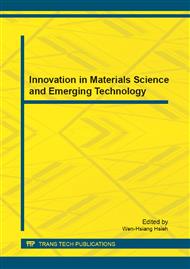p.73
p.78
p.83
p.88
p.93
p.99
p.104
p.109
p.114
The Vibration Analysis of Bone Conduction for Bone-Anchored Hearing Aids: In Vivo Human Temporal Bone
Abstract:
This study constructed a 3D finite element model of temporal bone non-invasively, based on the computed tomography scan image of an in vivo temporal bone. To observe the geometry and measurements of the temporal bone, the finite element model was built using ANSYS®. The finite element model involved two phases. The first phase entailed discussing the natural vibration frequencies and vibration mode of the temporal bone. The second phase involved investigating the harmonic response. The base center and center line were established in the external auditory meatus and the 0 degree direction, respectively. The amplitude force was applied along the center line and at 15 degrees from center line and at distances of 30 mm, 35 mm, and 40 mm from the center point of ear canal. The amplitude of the bone-anchored hearing aids was approximately 550 g when stimulated by the vibrator. This paper discusses the frequency responses and characteristics of the BAHA vibrator on the mastoid of the temporal bone at the frequencies of 125 Hz, 250 Hz, 500 Hz, 750 Hz, 1 kHz, 2 kHz, 3 kHz, 4 kHz, 5 kHz, 6 kHz, 7 kHz, 8 kHz. Based on the results of conducting modal analysis of the temporal bone, 11 natural frequencies, 125 Hz, 250 Hz, 500 Hz, 750 Hz, 1 k Hz, 2 kHz, 3 kHz, 4 kHz, 5 kHz, 6 kHz, and 7 kHz, included the stimuli frequencies of pure tone audiometry. Based on the results obtained by conducting harmonic analysis of the temporal bone, the performance of bone conduction at 35 mm and at 15 degrees was higher than those at 0 and -15 degrees.
Info:
Periodical:
Pages:
93-98
Citation:
Online since:
December 2011
Authors:
Price:
Сopyright:
© 2012 Trans Tech Publications Ltd. All Rights Reserved
Share:
Citation:


